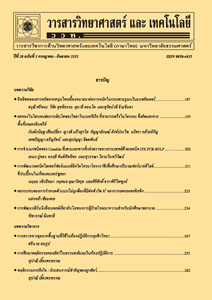การเปรียบเทียบประสิทธิภาพการทำลายแบคทีเรียด้วยความร้อนสูงจากแผ่นเซรามิคกับตะเกียงบุนเซนในห้องปฏิบัติการทางการแพทย์
Main Article Content
Abstract
บทคัดย่อ
การศึกษานี้มีจุดประสงค์เพื่อเปรียบเทียบประสิทธิภาพในการทำลายแบคทีเรียด้วยความร้อนสูงจากแผ่นเซรามิคกับเปลวไฟตะเกียงบุนเซน โดยหลักการฆ่าเชื้อด้วยความร้อนโดยตรง ในการทดลองนี้ได้นำแบคทีเรียมาทดสอบ กลุ่มแบคทีเรียที่ไม่สร้างสปอร์ ได้แก่ Pseudomonas aeruginosa, Salmonella Typhimurium, Enterococcus faecalis, Enterobacter aerogenes, Escherichia coli, Staphylococcus aureus และกลุ่มแบคทีเรียที่สร้างสปอร์ คือ Geobacillus stearothermophilus โดยเพาะเชื้อใน nutrient medium นาน 24 ชั่วโมง นำมาทดสอบเขี่ยเชื้อจากโคโลนีและทดสอบวัดความขุ่น โดยใช้เชื้อที่เจือจางปรับความขุ่นที่เหมาะสม พบว่าเปอร์เซ็นต์การรอดชีวิตของแบคทีเรียหลังจากถูกทำลายด้วยความร้อนโดยวิธี standard loop inoculation ไม่พบจำนวนโคโลนีของแบคทีเรีย โดยกำหนดเวลาทดสอบที่อุณหภูมิต่าง ๆ แบคทีเรียจะถูกฆ่าตายอย่างสมบูรณ์ในเวลาต่าง ๆ ที่กำหนด เมื่อเปรียบเทียบประสิทธิภาพของเครื่อง จากผลการทดลองพบว่าที่อุณหภูมิ 135 oC สามารถฆ่าแบคทีเรียทั้ง 2 กลุ่ม ได้ทั้งหมด เมื่อเปรียบเทียบแบคทีเรียที่สร้างสปอร์ ถ้าทดสอบด้วยความร้อนที่อุณหภูมิ 55 oC เวลา 5 นาที พบว่าเชื้อรอดชีวิต ร้อยละ75 เทียบกับแบคทีเรียที่ไม่สร้างสปอร์จะถูกฆ่าด้วยความร้อนที่อุณหภูมิ 55 oC เวลา 5 นาทีอย่างสมบูรณ์ ดังนั้นการศึกษาครั้งนี้ พบว่าอุณหภูมิที่มีประสิทธิภาพในการลดลงของจำนวนแบคทีเรียที่ไม่สร้างสปอร์ด้วยความร้อนอย่างน้อยที่อุณหภูมิ 55 oC ยกเว้นแบคทีเรียที่สามารถสร้างสปอร์ ผลที่ได้จากการทดลองนี้ คือ เครื่องมือทั้งสองสามารถลดจำนวนของแบคทีเรียได้ โดยเครื่องที่พัฒนาจากแผ่นเซรามิคมีประสิทธิภาพและความปลอดภัย สามารถนำมาใช้ในห้องปฏิบัติการทางการแพทย์ได้
คำสำคัญ : Geobacillus stearothermophilus; เครื่องเซรามิคความร้อนสูง; ตะเกียงบุนเซน; สเตอริไลเซชันด้วยความร้อน
Abstract
This study was to determine the efficacy bacterial sterilization between ceramic heater and Bunsen burner. For this research was used the direct heat sterilization. Livable non-spore forming bacteria are Pseudomonas aeruginosa, Salmonella Typhimurium, Enterococcus faecalis, Enterobacter aerogenes, Escherichia coli, Staphylococcus aureus and spore forming bacteria such as Geobacillus stearothermophilus were included and cultured in Nutrient medium for 24 hours. Direct colony inoculation were tested and measured for optimum turbidity. Compared with non-spore forming bacteria and spore forming bacteria were completely reduced by direct heat condition. Percentages of viable bacteria after heat exposure were measured on colony counting plate method. Timing set were recorded with different heating temperatures. All bacteria were completely killed at average temperature of 135 oC. Comparing viability of non-spore forming bacteria were completely killed at 55 oC for 5 mins and spore forming bacteria, only Geobacillus stearothermophilus was showed 75 percent of viability, respectively. This result is presented the efficiency of heater device were reduced viability with optimum heat temperature for spore and non-spore forming bacteria. The ceramic heater is safety and can be used in medical laboratory.
Keywords: Geobacillus stearothermophilus; ceramic heater; Bunsen burner; heat sterilization


